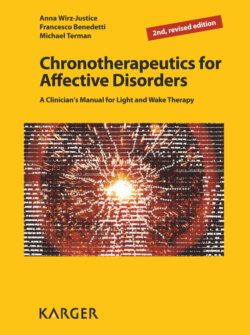Читать книгу Chronotherapeutics for Affective Disorders - M. Terman - Страница 12
На сайте Литреса книга снята с продажи.
1.2 Role of Biological Rhythms in Psychiatry
ОглавлениеOne of the most striking clinical phenomena in affective disorders is its periodicity – ranging from seasonal, as in winter depression, to rapid cycling [3] (fig. 2), which can be as short as 48 h. Other periodic phenomena are found at the symptom level: diurnal variation of mood, early morning awakening and sleep disturbances. A great deal of research has documented abnormal circadian rhythms in biochemistry, neuroendocrine function, physiology and behaviour in depressed patients [4]. The findings point towards increased variability in day-to-day rhythms, low circadian amplitude, and abnormal circadian timing – either too early or too late. Bipolar disorder is most clearly linked to changes in circadian timing with clinical state.
Fig. 3. Schematic representation of the circadian timing system. Light is the primary zeitgeber (‘time-giver’ or synchronising agent) for the biological clock in the SCN , via specialised circadian photoreceptors in the retina. A multisynaptic pathway to the pineal gland drives the nocturnal synthesis of melatonin and enables its suppression by light. Melatonin feeds back on receptors in the SCN . The SCN also synchronises the timing of peripheral clocks in other organs and cells, some of which have their own zeitgebers (e.g. food for the liver clock). There are multiple connections from (and to) the SCN with areas of the brain involved in sleep regulation.
